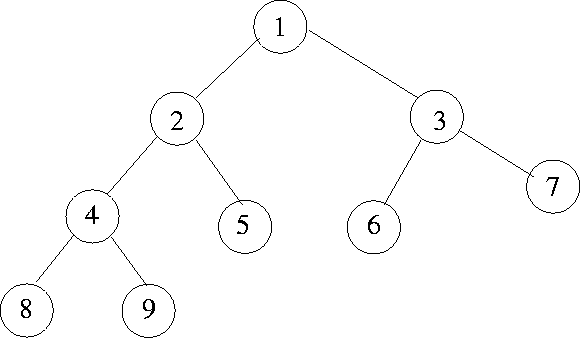public class LeastCommonAncestor {
private TreeNode root;
private static class TreeNode {
TreeNode left;
TreeNode right;
int item;
TreeNode (TreeNode left, TreeNode right, int item) {
this.left = left;
this.right = right;
this.item = item;
}
}
public void createBinaryTree (Integer[] arr) {
if (arr == null) {
throw new NullPointerException("The input array is null.");
}
root = new TreeNode(null, null, arr[0]);
final Queue<TreeNode> queue = new LinkedList<TreeNode>();
queue.add(root);
final int half = arr.length / 2;
for (int i = 0; i < half; i++) {
if (arr[i] != null) {
final TreeNode current = queue.poll();
final int left = 2 * i + 1;
final int right = 2 * i + 2;
if (arr[left] != null) {
current.left = new TreeNode(null, null, arr[left]);
queue.add(current.left);
}
if (right < arr.length && arr[right] != null) {
current.right = new TreeNode(null, null, arr[right]);
queue.add(current.right);
}
}
}
}
private static class LCAData {
TreeNode lca;
int count;
public LCAData(TreeNode parent, int count) {
this.lca = parent;
this.count = count;
}
}
public int leastCommonAncestor(int n1, int n2) {
if (root == null) {
throw new NoSuchElementException("The tree is empty.");
}
LCAData lcaData = new LCAData(null, 0);
foundMatchAndDuplicate (root, lcaData, n1, n2, new HashSet<Integer>());
if (lcaData.lca != null) {
return lcaData.lca.item;
} else {
throw new IllegalArgumentException("The tree does not contain either one or more of input data. ");
}
}
private boolean foundMatchAndDuplicate (TreeNode node, LCAData lcaData, int n1, int n2, Set<Integer> set) {
if (node == null) {
return false;
}
if (lcaData.count == 2) {
return false;
}
if ((node.item == n1 || node.item == n2) && lcaData.count == 1) {
if (!set.contains(node.item)) {
lcaData.count++;
return true;
}
}
boolean foundInCurrent = false;
if (node.item == n1 || node.item == n2) {
if (!set.contains(node.item)) {
set.add(node.item);
lcaData.count++;
}
foundInCurrent = true;
}
boolean foundInLeft = foundMatchAndDuplicate(node.left, lcaData, n1, n2, set);
boolean foundInRight = foundMatchAndDuplicate(node.right, lcaData, n1, n2, set);
if (((foundInLeft && foundInRight) ||
(foundInCurrent && foundInRight) ||
(foundInCurrent && foundInLeft)) &&
lcaData.lca == null) {
lcaData.lca = node;
return true;
}
return foundInCurrent || (foundInLeft || foundInRight);
}
public static void main(String args[]) {
Integer[] arr1 = {1, 2, 3, 4, null, 6, 7, 8, null, null, null, null, 9};
LeastCommonAncestor commonAncestor = new LeastCommonAncestor();
commonAncestor.createBinaryTree(arr1);
int ancestor = commonAncestor.leastCommonAncestor(2, 4);
System.out.println("Expected 2, actual " + ancestor);
ancestor = commonAncestor.leastCommonAncestor(2, 7);
System.out.println("Expected 1, actual " +ancestor);
ancestor = commonAncestor.leastCommonAncestor(2, 6);
System.out.println("Expected 1, actual " + ancestor);
ancestor = commonAncestor.leastCommonAncestor(2, 1);
System.out.println("Expected 1, actual " +ancestor);
ancestor = commonAncestor.leastCommonAncestor(3, 8);
System.out.println("Expected 1, actual " +ancestor);
ancestor = commonAncestor.leastCommonAncestor(7, 9);
System.out.println("Expected 3, actual " +ancestor);
try {
ancestor = commonAncestor.leastCommonAncestor(7, 7);
} catch (Exception e) {
System.out.println("expected exception");
}
Integer[] arr2 = {1, 2, 8, 4, null, 6, 7, 8, null, null, null, null, 9};
commonAncestor = new LeastCommonAncestor();
commonAncestor.createBinaryTree(arr2);
ancestor = commonAncestor.leastCommonAncestor(8, 8);
System.out.println("Expected 1, actual " + ancestor);
ancestor = commonAncestor.leastCommonAncestor(4, 8);
System.out.println("Expected 4, actual " +ancestor);
ancestor = commonAncestor.leastCommonAncestor(7, 8);
System.out.println("Expected 8, actual " +ancestor);
ancestor = commonAncestor.leastCommonAncestor(2, 6);
System.out.println("Expected 1, actual " + ancestor);
ancestor = commonAncestor.leastCommonAncestor(8, 9);
System.out.println("Expected 8, actual " +ancestor);
}
}
